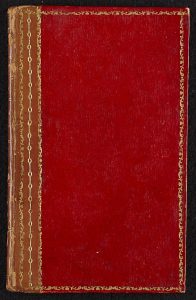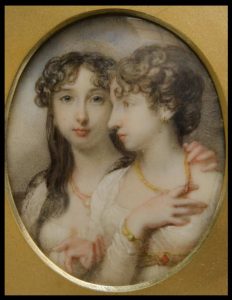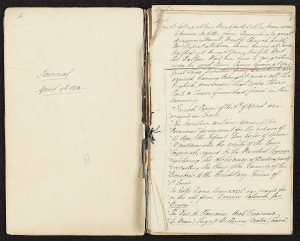Three Little Mice in a Grand World: The Journals of Charlotte and Mary Hill, Part One
- 12th May 2025
The remarkable journals of two sisters offer a glimpse into Regency life and throw light on their place in the Sandys story.
Ladies Charlotte and Mary Hill were the daughters of Mary Sandys, heiress of Ombersley Court in Worcestershire, and her husband Arthur Hill. Born in 1794 and 1796, the sisters were the third and fourth of the couple’s seven children. Their jointly written journals are held in our Sandys Archive – twenty six volumes of neat little writing, kept for eight years with only occasional gaps until shortly after Charlotte’s premature death in 1821.

The Journal of Ladies Charlotte and Mary Hill, Volume 1, 1814 – Reference: 705:56 BA16936/26/4
The journals begin 1812, with an eighteen year old Charlotte’s account of a trip to Ireland for the christening of the son of their eldest brother Arthur. Nearly twelve years after their father’s death, the girls live at home with ‘Mama’ in a large house on the corner of Hanover Square, London. Ladies in waiting to a popular regency hostess, Charlotte and Mary ensured the smooth running of their mother’s domestic affairs and were responsible for much of the housekeeping.
Their two elder brothers, referred to in the journals as ‘Downshire’ and ‘Atty’, live oversees – ‘Atty’ as a cavalry officer serving under Wellington (a cousin) in the battle against Napoleon. Their younger brothers Marcus and Augustus live with their tutor in Bedfordshire. Georgy, the youngest, is tutored at home but separately to his sisters.
The girls took lessons in music, art and languages. Enthusiastic musicians, they sang and played the piano together – often performing recitals for their London neighbours. Charlotte even sat for a sculptor. Yet it is their love of books that is most palpable. Sections of their ‘dear journal’ are also written in French – a language their mother is said to have made her children speak even before English.

Ladies Charlotte and Mary Hill, aged 18 and 16, by Richard Cosway, watercolour on ivory, 1812 – © Trustees of the Ombersley Conservation Trust
Home and the focus of life was London. The sisters attended balls, enjoyed frequent visits to the ballet, opera and theatre. Their social circle included royalty, distinguished members of the military and Whig politicians, as well as several other Lords and Ladies. Names are dropped on almost every page and their preoccupation with social events is evident. Details of their busy social life are often accompanied by their opinions, news of scandal, gossip and a good deal of humour. It is likely the sisters wrote alternate entries, but since their outlook is shared and their handwriting similar it is sometimes hard to tell exactly who wrote what.
Besides Hanover Square, Charlotte and Mary also lived in the family homes in Brighton and Roehampton, where they often looked forward to retreating to from ‘beastly London’.
‘Received a note from Mama to tell us that circumstances oblige her [and them] to remain in London!!!!!! Reasoned ourselves into it: and made up our minds to the disappointment.’
In 1814, the family made a rare visit to Ombersley Court. Mary Sandys extensive remodeling of which took place during most of the period covered by the journals.
‘Ombersley is a fine place, and we shall be glad to come here when…the house is in a more comfortable state…Such an immense House! Certainly, it is beautiful but us three little mice (as Mama says) are quite lost in it.’
These earlier journals are particularly interesting where they track the progress of the Napoleonic Wars – Wellington’s victories, Napoleon’s defeat, his exile and escape from Elba, with entries describing something of the buzz created by the news of his abdication. Later, they recall a six week journey to Paris one month after the Battle of Waterloo – the upshot of which meant the reopening of the city as a place the sisters could visit. Most obvious, however, is Charlotte and Mary’s concern for Atty. Indeed, the girls’ affection for their brothers is an underlying theme of the journals, as is a deep devotion to their mother.

The journalists note news of Napoleon’s dethroning, The Journal of Ladies Charlotte and Mary Hill, Volume 3, 1814 – Reference: 705:56 BA16936/26/6
When the exiled King Louis XVIII was entered into public in London, the sisters’ attended an audience with the King’s niece, the ‘handsome’ Duchess d’Angouleme and later met Louis himself. ‘We had the honour of being presented to his Majesty’, they write. Upon arrival, the King called their mother to him and taking her by the hand told her ‘you can never be too close to me’.
‘He [Louis] is very fat and goutty and sat upon a chair all the time. He looked very much pleased and smiled very gratuitously to everyone who was presented to him. He seems very amiable and good humoured. He was dressed in the French Uniform and wore all his Orders besides that of the Garter.’
At first glance, Ladies Charlotte and Mary may seem to be little more than two pampered girls from the upper echelons of English society, and perhaps they were, but their journals are an interesting and worthy read nonetheless. The first thirteen include social commentary on several important historical events. They also tell the story of two strong willed young women living in male dominated society. As the years progress their entries become more detailed and their observations more frank – we simply couldn’t fit their story into just one blog.
The Sandys Archive is currently being catalogued as part of a two year project funded by the Ombersley Conservation Trust. You can track our progress and see what we find on our Sandys Archive project page.
If you would like to access any of the records mentioned in this blog, please submit an enquiry at ArchiveEnquiry (worcestershire.gov.uk) or speak to a member of archive staff on Level 2 of The Hive.
Post a Comment